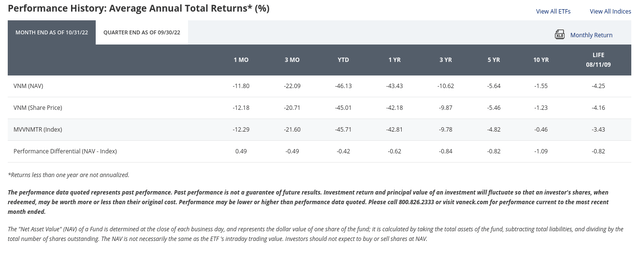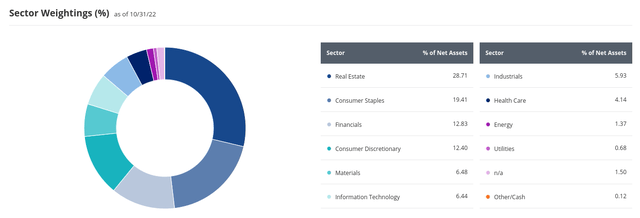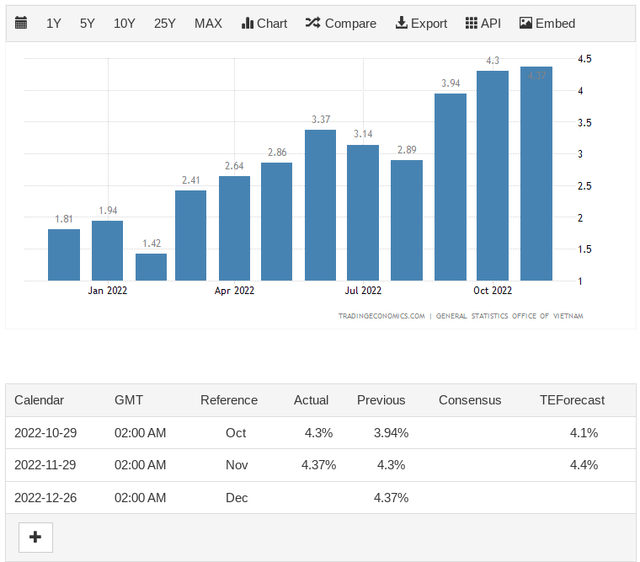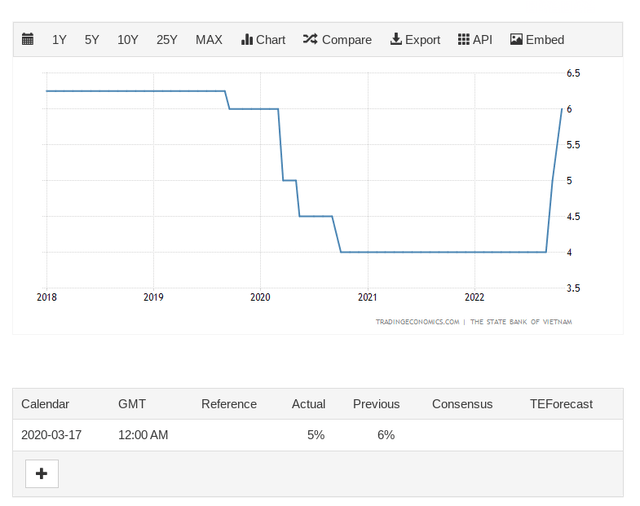VNM: Vietnam’s GDP Forecasts At Risk
hadynyah/iStock via Getty Images
Overview
The VanEck Vietnam ETF (BATS:VNM) provides exposure to Vietnamese companies. To be included in the fund, companies must be incorporated in, or derive at least 50% of their total revenue from, Vietnam.
As of 31st October 2022, the fund was invested in 59 different holdings. The fund has an expense ratio 0.59% per annum. There are currently only two exchange-traded funds (“ETFs”) which provides exposure to Vietnam, namely the VanEck Vietnam ETF (VNM) and the Global X MSCI Vietnam ETF (VNAM).
The VNM fund expense ratio is slightly more expensive than the ETF provided by Global X. However, according to FactSet, VNM is the largest and most liquid U.S. ETF that provides exposure to Vietnamese companies.
Fund performance
The VNM fund has returned –4.16% per annum since its inception in 2009. The fund has not been able to outperform its index (MVIS Vietnam Index), which returned –3.43% per annum.
The return on the VNM fund has been quite poor when compared with the S&P 500 Index (SP500) average return of 11.88% per annum since 1957.
A hypothetical investment of $10,000 made at inception in the VNM fund would be worth less today.
Investors have not been compensated for the higher risk associated with emerging market economies such as Vietnam.
The fund’s performance can be seen below:
Portfolio
The fund is heavily weighted towards the Real Estate (28.71%) and Consumer Staples (19.41%) sectors which represent nearly 50% of exposures.
On the other hand, the fund has very low exposure to Energy and Utilities, which is worth approximately 2% of the portfolio.
Vietnam outperforming neighboring economies
In September, the IMF revised Vietnam’s GDP forecast upwards to 7% per annum for 2022, which was in contrast to a wave of downward revisions for neighboring Asian economies.
According to the IMF, supportive policies such as low interest rates and the government’s Program for Socioeconomic Recovery and Development have helped Vietnam to outperform its neighbors.
IMF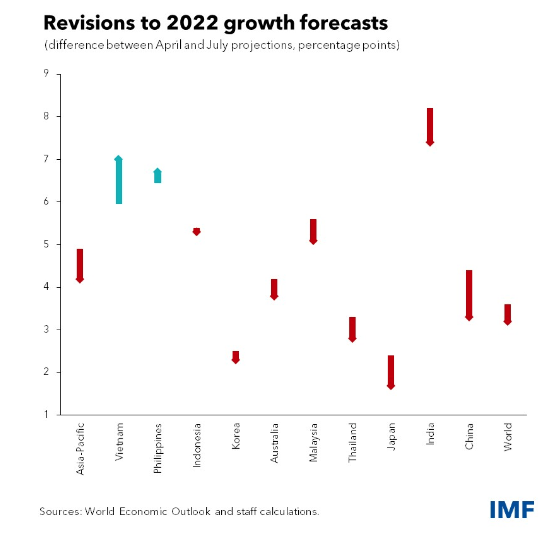
During the first three quarters of the year, Vietnam had been largely insulated from the inflationary pressures experienced by other economies. Vietnam was shielded from the global surge in food prices as it had sufficient domestic supplies.
Additionally, food staples such as pork have declined in prices from last year’s peak, and rice has remained cheaper than other grains such as wheat which were particularly affected by the Russia-Ukraine war.
However, things are changing. The annual inflation rate in Vietnam increased to 4.3% in October 2022 above the central bank’s target of 4%, posing some fresh challenges for the central bank.
Inflation is increasing due to a weakening Vietnamese dong against the U.S. dollar which is inflating the price of imports.
The U.S dollar has been rallying against other currencies this year as the Federal Reserve has been hiking interest rates to tame domestic inflationary pressures.
The State Bank of Vietnam had to raise interest rates by an extra 2%, bringing interest rates to 6%, a level not seen since February 2020.
The Vietnamese central bank has been forced to raise interest rates to fight off inflation and protect its currency against the rising dollar.
Additionally, a strong economy has given the central bank some leeway to raise interest rates.
However, the prospect of rising inflation and the central bank’s actions to increase interest rates will put the IMF growth projections at risk of being revised downwards.
On the fiscal front, Vietnam announced a $15 billion (VND 350 billion) package, the largest in its history, to support the country’s economy after the COVID-19 pandemic.
The government has also signed numerous free trade agreements in recent years which will help boost exports and gain access to foreign markets. For example, Vietnam has recently signed agreements with the EU and the UK.
Conclusion
The government’s positive actions have supported the IMF’s upward growth revision in September. However, inflation has been tracking upwards and there is a risk that high interest rates will restrain growth.
Investors should be aware that Vietnam’s growth projections are at risk of being revised downwards due to the risk of inflation and interest rates going higher.
If you enjoyed the article, please subscribe to receive my latest articles.



